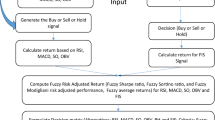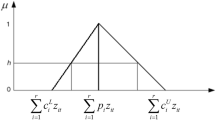Abstract
To support investment decision based on technical analysis (TA), this study aims to retrieve the knowledge or rules of various indicators by a hybrid soft computing model. Although the validity of TA has been examined extensively by various statistical methods in literature, previous studies mainly explored the effectiveness of each technical indicator separately; therefore, a practical approach that may consider the inconsistency of various technical indicators simultaneously and the down-side risk of an investment decision is still underexplored. Thus, a hybrid model—by constructing a variable consistency dominance-based rough set approach (VC-DRSA) information system with the fuzzy inference-enhanced discretization of signals—is proposed, to retrieve the imprecise patterns from commonly adopted technical indicators. At the first stage, the trading signals (i.e., buy, neutral, or sell) are preprocessed in two groups: straight-forward signals and complicated signals. The straight-forward technical indicators (i.e., for signals that are decided by precise rules) are suggested by domain experts, and the buy-in signals are simulated by several trading strategies to examine the outcomes of each indicator. As for those complicated signals (i.e., for signals that require imprecise judgments with perceived feeling of domain experts to identify patterns), a fuzzy inference technique is incorporated to enhance the discretization of signals; those signals are also simulated by the aforementioned trading strategies to obtain the corresponding results. At the second stage, the trading signals generated by each technical indicator and their pertinent results from the previous stage are combined for VC-DRSA modeling to gain decision rules. To illustrate the proposed model, the weighted average index of the Taiwan stock market was examined from mid/2002 to mid/2014, and a set of decision rules with nearly 80 % classification accuracy (both in the training and the testing sets) were obtained in this empirical case. The findings suggest that several technical indicators should be considered simultaneously, and the retrieved rules (knowledge) have practical implications for investors.





Similar content being viewed by others
References
Lo, A.W., Mamaysky, H., Wang, J.: Foundations of technical analysis: Computational algorithms, statistical inference, and empirical implementation. J. Financ. 55(4), 1705–1770 (2000)
Menkhoff, L.: The use of technical analysis by fund managers: international evidence. J. Bank. Financ. 34(11), 2573–2586 (2010)
Shiller, R.J.: From efficient market theory to behavioral finance. J. Econ. Perspect. 17(1), 19–33 (2003)
Froot, K.A., Scharfstein, D.S., Stein, J.C.: Herd on the street: informational inefficiencies in a market with short-term speculation. J. Financ. 47(4), 1461–1484 (1992)
Park, C.H., Irwin, S.H.: What do we know about the profitability of technical analysis? J. Econ. Surv. 21(4), 786–826 (2007)
Wei, L.Y., Chen, T.L., Ho, T.H.: A hybrid model based on adaptive-network-based fuzzy inference system to forecast Taiwan stock market. Expert Syst. Appl. 38(11), 13625–13631 (2011)
Enke, D., Thawornwong, S.: The use of data mining and neural networks for forecasting stock market returns. Expert Syst. Appl. 29(4), 927–940 (2005)
Ticknor, J.L.: A Bayesian regularized artificial neural network for stock market forecasting. Expert Syst. Appl. 40(4), 5501–5506 (2013)
Brown, M.S., Dynamic-radius species-conserving genetic algorithm for the financial forecasting of Dow Jones index stocks. Mach. Learn. Data Min. Pattern Recognit. Lecture Notes in Computer Science, vol. 7988, pp. 27–41 (2013)
Rosillo, R., Giner, J., Fuente, D.D.: Stock market simulation using support vector machines. J. Forecast. 33(6), 488–500 (2014)
Kim, K.J.: Financial time series forecasting using support vector machines. Neurocomputing 55(1–2), 307–319 (2003)
Tay, F.E.H., Cao, L.: Application of support vector machines in financial time series forecasting. Omega 29(4), 309–317 (2001)
Atsalakis, G.S., Valavanis, K.P.: Surveying stock market forecasting techniques—Part II: soft computing methods. Expert Syst. Appl. 36(3 (part 2)), 5932–5941 (2009)
Shen, K.Y.: Implementing value investing strategy by artificial neural network. Int. J. Bus. Inf. Technol. 1(1), 12–22 (2011)
Dourra, H., Siy, P.: Investment using technical analysis and fuzzy logic. Fuzzy Sets Syst. 127(2), 221–240 (2002)
Zhou, X.S., Dong, M.: Can fuzzy logic make technical analysis 20/20? Financ. Anal. J. 60(4), 54–75 (2004)
Wang, J.L., Chan, S.H.: Stock market trading rule discovery using two-layer bias decision tree. Expert Syst. Appl. 30(4), 605–611 (2006)
Boyacioglu, M.A., Avci, D.: An adaptive network-based fuzzy inference system (ANFIS) for the prediction of stock market return: the case of the Istanbul stock exchange. Expert Syst. Appl. 37(12), 7908–7912 (2010)
Cheng, C.H., Chen, T.L., Wei, L.Y.: A hybrid model based on rough set theory and genetic algorithms for stock price forecasting. Inf. Sci. 18(9), 1610–1629 (2010)
Gradojevic, N., Gencay, R.: Fuzzy logic, trading uncertainty and technical trading. J. Bank. Financ 37(2), 578–586 (2013)
Taylor, N.: The rise and fall of technical trading rule success. J. Bank. Finance 40, 286–302 (2014)
Menkhoff, L., Taylor, M.P.: The obstinate passion of foreign exchange professionals: technical analysis. J. Econ. Lit. 45(4), 936–972 (2007)
Lam, M.: Neural network techniques for financial performance prediction: integrating fundamental and technical analysis. Decis. Support Syst. 37(4), 567–581 (2004)
Fernando, F.R., Christian, G.M., Simon, S.R.: On the profitability of technical trading rules based on artificial neural networks: evidence from the Madrid stock market. Econ. Lett. 69(1), 89–94 (2000)
Zadeh, L.A.: Fuzzy sets. Inf. Control 8(3), 338–353 (1965)
Precup, R.E., Hellendoom, H.: A survey on industrial applications of fuzzy control. Comput. Ind. 62(3), 213–226 (2011)
Turskis, Z., Zavadskas, E.K.: Multiple criteria decision making (MCDM) methods in economics: an overview. Technol. Econ. Dev. Econ. 2, 397–427 (2011)
Liou, J.H., Tzeng, G.H.: Comments on “Multiple criteria decision making (MCDM) methods in economics: an overview”. Technol. Econ. Dev. Econ. 18(4), 672–695 (2012)
Tzeng, G.H., Huang, J.J.: Multiple attribute decision making: methods and applications. CRC Press, Boca Raton (2011)
Tzeng, G.H., Huang, J.J.: Fuzzy multiple objective decision making. CRC Press, Boca Raton (2013)
Peng, K.H., Tzeng, G.H.: A hybrid dynamic MADM model for problems-improvement in economics and business. Technol. Econ. Dev. Econ. 19(4), 638–660 (2013)
Liou, J.H., Chuang, Y.C., Tzeng, G.H.: A fuzzy integral-based model for supplier evaluation and improvement. Inf. Sci. 266(10), 199–217 (2014)
Shen, K.Y.: Implementing value investing strategy through an integrated fuzzy-ANN model. J. Theor. Appl. Inf. Technol. 51(1), 150–157 (2013)
Jang, J.S.R.: ANFIS: adaptive-network-based fuzzy inference system. IEEE Trans. Syst. Man Cybern. 23(3), 665–685 (1993)
Shen, K.Y., Tzeng, G.H.: DRSA-based neuro-fuzzy inference systems for the financial performance prediction of commercial banks. Int. J. Fuzzy Syst. 16(2), 173–183 (2014)
XQ global winners: SysJust Co. Ltd. http://www.sysjust.com.tw (2014). Accessed June 2014
Achelis, S.B.: Technical Analysis from A to Z. McGraw Hill, New York (2001)
Mamdani, E.H., Assilian, S.: An experiment in linguistic synhesis with a fuzzy logic controller. Int. J. Man Mach. Stud. 7(1), 1–13 (1975)
Kandel, A., Li, L., Cao, Z.: Fuzzy inference and its applicability to control systems. Fuzzy Sets Syst. 48(1), 99–111 (2006)
Fernandez, A., Herrera, F.: Linguistic fuzzy rules in data mining: follow-up Mamdani fuzzy modeling principle. Comb. Exp. Theory (Stud. Fuzziness Soft Comput.) 271, 103–122 (2012)
Opricovic, S., Tzeng, G.H.: Defuzzification within a multicriteria decision model. Int. J. Uncertain. Fuzziness Knowl-Based Syst. 11(5), 635–652 (2003)
Greco, S., Matarazzo, B., Slowinski, R.: Rough sets theory for multicriteria decision analysis. Eur. J. Oper. Res. 129(1), 1–47 (2001)
Greco, S., Matarazzo, B., Slowinski, R.: Rough approximation by dominance relations. Int. J. Intell. Syst. 17(2), 153–171 (2002)
Greco, S., Matarazzo, B., Slowinski, R.: Rough sets methodology for sorting problems in presence of multiple attributes and criteria. Eur. J. Oper. Res. 138(2), 247–259 (2002)
Błaszczyński, J., Słowiński, R., Szeląg, M.: Sequential covering rule induction algorithm for variable consistency rough set approaches. Inf. Sci. 181(5), 987–1002 (2011)
Błaszczyński, J., Greco, S., Słowiński, R., Szeląg, M.: Monotonic variable consistency rough set approaches. In: Yao, J., Lingras, P., Wu, W.Z., Szczuka, M., Cercone, N., Slezak, D. (eds.) Rough Sets and Knowledge Technology, pp. 126–133. Springer, Berlin Heidelberg (2007)
Błaszczyński, J., Greco, S., Matarazzo, B., Słowiński, R., Szeląg, M.: jMAF dominance-based rough set data analysis framework. In: Skowron, A., Suraj, Z. (eds.) Rough Sets and Intelligent Systems-Professor Zdzisław Pawlak in Memoriam, pp. 185–209. Springer, Berlin Heidelberg (2013)
Acknowledgments
Advices and opinions provided by the professionals from the Foreign Investment Department of Treasury of a financial-holding company are deeply appreciated, and the technical supports from the manager of SysJust also helped us a lot. Authors appreciate those valuable assistances; also, we are grateful for the funding support from the project of Ministry of Science and Technology (101-2410-H-424-009-MY3).
Author information
Authors and Affiliations
Corresponding author
Appendix 1
Rights and permissions
About this article
Cite this article
Shen, KY., Tzeng, GH. Fuzzy Inference-Enhanced VC-DRSA Model for Technical Analysis: Investment Decision Aid. Int. J. Fuzzy Syst. 17, 375–389 (2015). https://doi.org/10.1007/s40815-015-0058-8
Received:
Revised:
Accepted:
Published:
Issue Date:
DOI: https://doi.org/10.1007/s40815-015-0058-8




